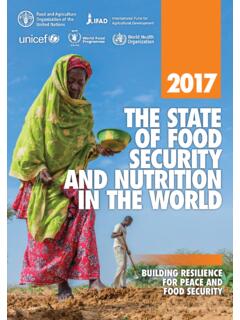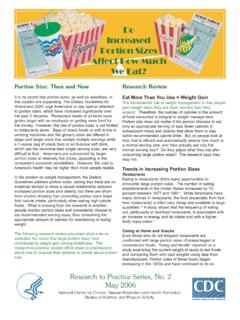Transcription of Special report: 2021 FAO Crop and Food Supply Assessment ...
1 Special REPORT. 2021 FAO CROP AND food Supply . Assessment MISSION TO. THE SYRIAN ARAB REPUBLIC. December 2021. Special REPORT. 2021 FAO CROP AND food Supply . Assessment MISSION TO. THE SYRIAN ARAB REPUBLIC. December 2021. food and Agriculture Organization of the United Nations Rome, 2021. Required citation: FAO. 2021. Special report: 2021 FAO Crop and food Supply Assessment Mission to the Syrian Arab Republic December 2021. Rome. The designations employed and the presentation of material in this information product do not imply the expression of any opinion whatsoever on the part of the food and Agriculture Organization of the United Nations (FAO) concerning the legal or development status of any country, territory, city or area or of its authorities, or concerning the delimitation of its frontiers or boundaries.
2 Dashed lines on maps represent approximate border lines for which there may not yet be full agreement. The mention of specific companies or products of manufacturers, whether or not these have been patented, does not imply that these have been endorsed or recommended by FAO in preference to others of a similar nature that are not mentioned. ISBN 978-92-5-135514-5. FAO, 2021. Some rights reserved. This work is made available under the Creative Commons Attribution-NonCommercial-ShareAlike IGO licence (CC BY-NC-SA IGO; ). Under the terms of this licence, this work may be copied, redistributed and adapted for non-commercial purposes, provided that the work is appropriately cited.
3 In any use of this work, there should be no suggestion that FAO endorses any specific organization, products or services. The use of the FAO logo is not permitted. If the work is adapted, then it must be licensed under the same or equivalent Creative Commons license. If a translation of this work is created, it must include the following disclaimer along with the required citation: This translation was not created by the food and Agriculture Organization of the United Nations (FAO). FAO is not responsible for the content or accuracy of this translation. The original [Language] edition shall be the authoritative edition.
4 Disputes arising under the licence that cannot be settled amicably will be resolved by mediation and arbitration as described in Article 8 of the licence except as otherwise provided herein. The applicable mediation rules will be the mediation rules of the World Intellectual Property Organization and any arbitration will be in accordance with the Arbitration Rules of the United Nations Commission on International Trade Law (UNCITRAL). Third-party materials. Users wishing to reuse material from this work that is attributed to a third party, such as tables, figures or images, are responsible for determining whether permission is needed for that reuse and for obtaining permission from the copyright holder.
5 The risk of claims resulting from infringement of any third-party-owned component in the work rests solely with the user. Sales, rights and licensing. FAO information products are available on the FAO website ( ) and can be purchased through Requests for commercial use should be submitted via: org/contact-us/licencerequest. Queries regarding rights and licensing should be submitted to: Cover photograph: FAO/Mazen Haffar CONTENTS. ACRONYMS AND ABBREVIATIONS v HIGHLIGHTS 1. OVERVIEW 3. Assessment methodology 3. BACKGROUND AND SOCIO-ECONOMIC CONTEXT 5. Security conditions 5. Economic environment 6. Syrian pound exchange rate 7.
6 food prices 8. Fuel 9. International sanctions 10. COVID-19 in the country 10. Agriculture 11. CEREAL PRODUCTION 15. Cereal area in 2020/21 15. Field fires 17. Factors affecting yields 18. Weather 18. Irrigation 25. Inputs 29. Crop protection materials 33. Mechanization 34. Labour 36. Pests and diseases 36. Cereal production, 2020/21 38. Yields 38. Production 38. OTHER CROPS 43. food legumes 44. Potatoes 44. Vegetables 45. Greenhouses produce 46. Fruit trees 47. Herbs 48. iii Industrial crops 49. Sugar beet 49. Cotton 49. Tobacco 50. LIVESTOCK 51. Livestock numbers 52. Sheep and goats 53. Cattle 53. Poultry 53. Other species 54.
7 Animal nutrition 54. Pastures 54. Feed and fodder 55. Water 57. Artificial insemination 58. Fisheries 58. Beekeeping 59. Animal health 59. CHALLENGES FACING THE AGRICULTURAL SECTOR 63. Farm access and movement of farmers and produce 64. Cereals 65. Fruits and vegetables 66. Cotton 68. Livestock markets 68. Live animal prices 69. Livestock product prices 70. Credit availability 71. CEREAL Supply AND DEMAND SITUATION 73. Population 73. National cereal balance sheet 73. Scenario analysis: Partial wheat availability 75. FUTURE TRENDS 77. RECOMMENDATIONS 79. Urgent needs 79. Medium-term actions 80. Long-term actions 82. REFERENCES 83.
8 Iv ACRONYMS AND ABBREVIATIONS. AANES Autonomous Administration of North and East Syria ACB Agricultural Cooperative Bank AEZs agro-ecological zones AI artificial insemination ASI Agricultural Stress Index bbl/d barrels per day CFSAM Crop and food Supply Assessment Mission CHIRPS Climate Hazards Group InfraRed Precipitation with Station data EIU Economist Intelligence Unit ESA European Space Agency ESCWA Economic and Social Commission for Western Asia FAO food and Agriculture Organization of the United Nations FAOSTAT Data programme of FAO Statistics Division FAW Fall Armyworm FGDs focus group discussions FMD foot-and-mouth disease GDP Gross
9 Domestic product GIEWS Global Information and Early Warning System on food and Agriculture GOF General Organization for Feed GORS General Organization for Remote Sensing GOSM General Organization for Seed Multiplication GOT General Organization of Tobacco Hoboob General Establishment for Cereal Trade and Processing IDPs Internally displaced persons IFAD International Fund for Agricultural Development kg kilogramme MAAR Ministry of Agriculture and Agrarian Reform MITCP Ministry of Internal Trade and Consumer Protection mm millimetres MWR Ministry of Water Resources OCHA United Nations Office for the Coordination of Humanitarian Affairs OHCHR United Nations Office of the high Commissioner for Human Rights PPR Peste des petits ruminants v RAATA Ras Al Ain and Tell Abiad SCB Syrian Central Bank SDF Syrian Democratic Forces SYP Syrian pound UN United Nations UNHCR United Nations high Commissioner for Refugees USD United States dollar WFP World food Programme WHO World Health Organization vi HIGHLIGHTS.
10 Socio-economic background: Although much of the country is now stable and only pockets of active fighting remain contained, the economic conditions are not considered favourable. Already weakened by 10 years of conflict, the economy suffered further setbacks from the COVID-19 pandemic and spill-over effects from the economic crisis in Lebanon, long a lifeline of the Syrian economy. high inflation rates, weakening currency and shortages of basic FAO/Mazen Haffar products, including fuel, prevail. International sanctions have generally affected livelihoods of millions of Syrians, directly or indirectly. According to the World food Programme (WFP), more than million people (60 percent of the population) were food insecure in 2020, Main agricultural constraints for crop million more than in The food security production: Farmers continue flagging situation has continued to worsen in 2021.

















